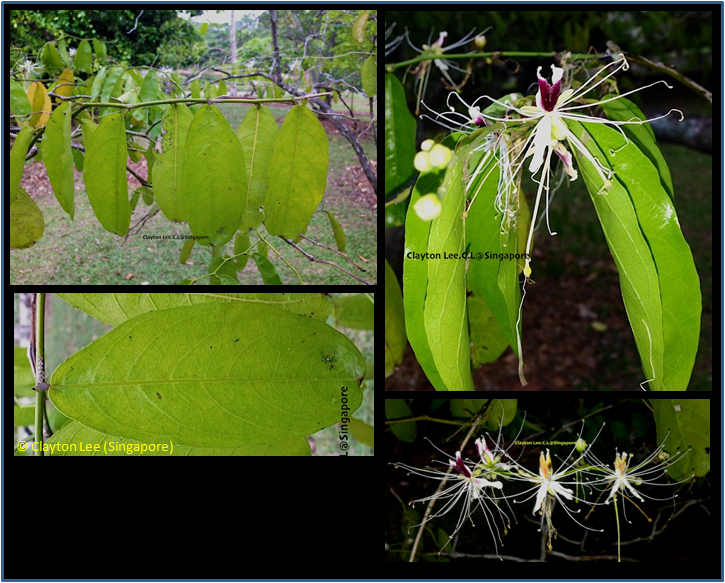Capparis micrantha A.Rich., Tent. Fl. Abyss. 1: 31 (1847)
Species name meaning 'small anthers', referring to the stamens.Synonyms
Capparis liangii Merrill & Chun.
Remark
This species may be a synonym of Capparis sepiaria.
Diagnostics
Scandent shrubs to small trees. Often with stipular spines that can remain present on the
branches and stem. Leaves alternate. The flowers are very
distinctive, with five normally shaped greenish sepals, petals white, with upper ones seemingly
fused and pruplish or yellowish tinged, with many long white stamens like wiskers. Fruit an orange-
red berry with many seeds in whitish pulp.
Description
Shrubs or small trees, sometimes scandent. Twigs nearly terete, base with subulate scales, with
or without 2-4 mm stipular spines; new twigs glabrous or sparsely shortly pubescent. Petiole
1-2.2 cm; leaf blade oblong-elliptic, oblong-lanceolate, or sometimes ovate-lanceolate,
(10-)15-20(-30) x (4-)6-10 cm, membranous when young but leathery when mature, often yellowish
green when dry, glabrous, shiny, midvein adaxially slightly raised but central part often grooved,
secondary veins (5-)7-10 on each side of midvein, reticulate veins obvious on both surfaces, base
cuneate, broadly cuneate, rounded, or sometimes slightly cordate, apex obtuse, rounded, sometimes
acute to shortly acuminate, or rarely emarginate. Inflorescences superaxillary rows, 2-7-flowered,
above apical axils, with clusters of 1-4 subulate spines 1-1.5 mm between lowest pedicel and
petiole. Pedicel ca. 6 mm for basal flowers, ca. 2 cm for apical flowers, pubescent. Sepals ovate
to oblong, 6-10 x 3-4 mm, +/- equal, glabrous but margin often tomentose, apex acute to obtuse.
Petals white, oblong to oblanceolate, 1-2.1 x 0.3-0.7 cm, glabrous, narrowly cuneate, apex almost
rounded. Stamens 20-40; filaments (1.5-)1.8-2.5 cm; anthers 1-1.5 mm. Gynophore 2-3.5 cm, glabrous;
ovary ovoid to ellipsoid, 2.5-3 mm, with 4 lengthwise grooves; placentae 4; ovules many. Fruit tan,
spheroid to ellipsoid, 3-7 x 3-4 cm, surface with 4 slightly obvious to not obvious vertical
grooves; pericarp orangish red, ca. 3 mm thick; fruiting gynophore 4-6 mm in diam., woody. Seeds
numerous per fruit, dark red, 6-8 x 4-5 x 3-4 mm. [from Flora of China]
Ecology
Forest, among shrubs, often along rivers and creeks, up to 2000 m elevation.
Distribution
From India into southern China and Hainan, into Indochina, Peninsular Malaysia, western Indonesia
and the Philippines.
Usese
The juice from the roots is used as a drink to reduce fever, to promote urination, and as a
remedy against a cough. The wood is smoked to heal syphilitic ulceration of the nose and the seeds
are used to treat cough. In the Philippines a decoction of the root is used as a drink to assuage
stomachache, and to invigorate after childbirth. Indonesians use the wood to assuage stomachache
and to treat biliousness and dizziness. Fruits are edible.
Local names
China: Xiao ci shan gan.
English: Caper thorn, Naper tree.
Philippines: Halubagat-kahoy, Halubagat.
